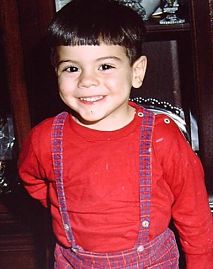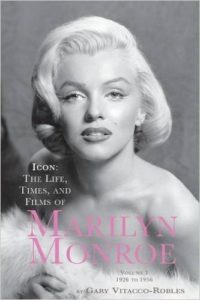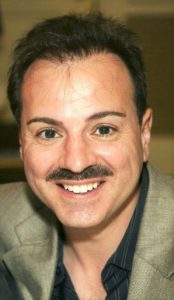Captivated by Marilyn – A Brief Biography of Gary Vitacco-Robles
#sexsymbol #marilynmonroe #fifties #cinema
This is the third in a series about Gary Vitacco-Robles, the author of the monumental biography ICON:The Life, Times and Films of Marilyn Monroe, Volumes I and II. I have reviewed both volumes and published two segments of my interview with Vitacco-Robles. In this installment, I asked him to share something about his personal life.
Gary, the biographical information on you is quite sketchy as presented by the usual sources. Please fills us in on your background.
I was born to a warm Italian family and lived until age 10 in Flushing/Bayside New York. In 1975, my family relocated to a rural area north of the Tampa Bay – a severe culture shock for me, but I grew to enjoy how generations of Florida-born residents were melding with transplanted families from the northeast.
I was an honor student in high school, president of the drama club, editor of the yearbook, and involved in many other school and community organizations. Entering St. Petersburg College in 1983, I majored in architecture with an emphasis on Speech English Education. It was there that I was encouraged to consider mental health counseling. I transferred to the University of South Florida, Tampa, and majored in Psychology with electives in theater and Women’s Studies. Graduating in 1987, I went to work at a local community mental health center assisting adults who suffered from severe and persistent mental illness as they transitioned from state psychiatric hospitals into the community. I was promoted to case manager and ultimately to program supervisor. I completed my masters at USF in Counseling Education.
My first position as a therapist was in a program specializing in trauma-informed treatment of youth and families who had survived physical/sexual abuse and neglect and children with sexual behavior problems. I became licensed as Mental Health Counselor in Florida in 1997 and a Nationally Certified Counselor in 1998. I’ve remained at the same organization for thirty years and currently supervise an adult and children outpatient department. I am a founding member of a sexual abuse intervention network to prevent child sexual abuse and respond to children and youth with sexual behavior problems. For about five years, I had a concurrent private practice in Tampa.
My spouse and I met 26 years ago. I consider my marriage and the life my spouse and I created together my greatest achievement. We have enjoyed tremendous support from our families as a same gender couple. We are also very grateful for the support we have received from the relatively conservative area where we live.
When did you first become interested in Marilyn Monroe?

Earlier Photo of Gary and Oscar Vitacco Robles – Partners for over 26 years. Commitment Ceremony 1994. Civil Union 2000. Married 2004
Marilyn has always chased and haunted me. Norman Mailer’s biography of her was published in 1973 when I was eight. Images of her were everywhere when I was in junior high in the late 1970s. One that comes clearly to mind was Milton Greene’s iconic “ballerina” pose. Her soulful eyes captivated me like none other I have ever seen. I also remember Bert Stern’s portraits originally for Vogue in 1962 being widely circulated in the late 70’s and early 80’s.
I saw Bus Stop and The Prince and the Showgirl back to back when I was in junior high school. They were my first Monroe movies. Her performances moved me. I quickly found and devoured Fred Lawrence’s 1960 biography, Norma Jeane, The Life of Marilyn Monroe, Edward Waghenknecht’s Marilyn: A Composite View, and Norman Mailers Marilyn: A Biography from 1972. I was immediately fascinated and felt tremendous compassion for her. Despite her tragic early death, I saw her as a resilient survivor.
Over the years, I’ve read at least 200 biographies. I recommend the works of Fred Lawrence Guiles, Maurice Zolotow, Donald Spoto, and Michelle Morgan. As for memoirs, look to the works of Norman Rosten, Sam Shaw – Rosten & Shaw’s Marilyn Among Friends – Susan Strasberg, and Berniece Miracle. Since my volumes contain over 1500 pages of text with no photos, Monroe photo books make the perfect companion. James Spada’s is a personal favorite from 1982. Also the photo books of George Barris and Bert Stern’s The Complete Last Sitting. The auction catalogues like Christie’s The Personal Property of Marilyn Monroe from 1999 is a good source. Marilyn Monroe’s My Story is a primer. Fragments contain images of pages from her personal diaries and letters.
Richard Meryman’s lengthy Life 1962 interview and Allan Levy’s for Redbook the same year are fascinating. I recommend documentaries which include audiotapes of Meryman’s interview of Marilyn as well as Georges Belmont’s for Marie Clare magazine, the latter recorded in 1960. Both men asked brief open-ended questions which allowed Marilyn to expound in two of the most revealing narratives. They are a significant record of her thoughts and insights about her life because she speaks in her natural voice recalling the events of her life and commenting on her daily routines. The result is the closest glimpse of her true self available to us today.
When did you realize that you wanted to become a writer?
I have been writing short stories and plays since junior high school. Two books had a major impact on me. The Diary of Anne Frank is the book of all books with its spiritual content. It is almost a miracle that it survived. To Kill a Mockingbird is another great book that changed the world. Harper Lee’s backstory fascinated me. She attained distinction despite not being prolific.
I set a goal at age fourteen on New Year’s Eve 1979-80 to become published someday . My English teachers saw me as a playwright or mystery novelist. A young woman, Courtenay O’Connell Sims, was my mentor in junior high school. She encouraged me to take a chance on publishing. We’re lifelong friends to this day. She gave the toast at my wedding.
Publishing biographies about Marilyn have been my only success. My first effort, Cursum Perficio: Marilyn Monroe’s Brentwood Hacienda/The Story of Her Final Years, turned out to be self-prescribed occupational therapy. I self-published it through iUniverse in 2000. The book focused on Marilyn’s renovation of a home in the last months of her life. The renovation, incomplete at the time of her death, is an obvious metaphor for her unfinished life and premature death. The second edition of Cursum Perfico resonated with readers because it was professionally illustrated by Brandon Heidrick. The book prompted many to encourage me to write a full-length biography.
What plans do you have for your next book?
I’ve been involved since February of 2015 in the Goodnight, Marilyn radio show investigation into Marilyn’s death. Nina Boski and Randall Libero have had me as a frequent guest and I am currently a weekly panel member for three seasons, I will be an investigative team member for the Seeking the Truth Conference in Los Angeles in 2017. I’ve recently acquired the 641-page LA District Attorney’s investigation materials and final report from 1982. I’ve been privileged to consult with forensic experts including psychiatrists Dr. Cyril Wecht, Dr. Reef Kareem, and suicide expert Dr. Scott Bonn. This 21st century investigation will yield new results and impact our perceptions about her death. I intend to publish the findings in Volume III and have received encouragement from Ben Ohmart, my publisher (BearManor Media) who is very interested. The next volume, ICON: The Life, Times and Films of Marilyn Monroe, Volume 3 – The 1982 and 2016 Investigations into Her Death (the current working title) will be the largest volume in completing the trilogy.
What if Marilyn Monroe had lived? How would her career have taken shape if she lived to the fullness of her years?
Marilyn, as a woman of 40, would have to survive the turbulent 1960s in film. She would have turned 40 in 1966. The studio system had collapsed, and freelancing and independent films were the norm. Changing times challenged actresses over 40, although the new freedoms and cultural revolution were liberating and allowed for creativity. Some of the notable female performances included Elizabeth Taylor in Who’s Afraid of Virginia Woolf? and Anne Bancroft in The Graduate.
The 1970s ushered a cultural nostalgia for the 1950s and the veterans of the Golden Age of Film, an era for which Marilyn was the icon. I believe she would have made a come-back. Consider the ensemble casts of Hollywood greats in the disaster films of the 70s: The Towering Inferno (Fed Astaire), The Poseidon Adventure (Ernest Borgnine, Shelley Winters, Red Buttons), Earthquake (Eva Gardner) and Airport ’75 (Gloria Swanson). Marilyn might team again with Jack Lemon in the Sandy Dennis’ role in the hilarious The Out of Towners in 1970. Marilyn as Auntie Mame in 1974 seems better cast than Lucille Ball. The public would have seen a more mature Marilyn, but her growth as an artist qualified for these roles and she would have remained relevant and become rediscovered by another generation.
In 1962, Marilyn stated her desire was to become a character actress. Aging and television would have provided an opportunity. Television was a burgeoning option for stars of the 50s with its sitcoms, dramas, variety shows and specials. The new made-for-television movies would have been a medium for Marilyn as she moved into her late 40s and early 50s, affording her ample opportunity to enjoy success as a dramatic actress. TV was less expensive and more creative than film at that time and holds true even today.
Shirley MacLaine’s later film career suggests what Marilyn could have achieved in film in the 1980s and beyond. Think of her in Terms of Endearment, Used People, Steel Magnolias. She would have had to turn to television in the 1970s to secure a film presence later. Comedy and self-parody were both options: The Golden Girls, perhaps even a sequel to Some Like It Hot. Marilyn belongs to the boomer generation after all, the largest single group in the population. Her aging would be revered as boomers strove to remain young on the tennis courts, in exercise studios and on the golf links.
In a parallel universe, Marilyn would also remarrie DiMaggio and retire to a ranch in Carmel (like Doris Day and Kim Novak),where she’d rescue animals and abandon film altogether until someone like Ron Howard or Tom Hanks would coax her out of reclusion and retirement for a sexy elderly mother role.
The high level of interest in Marilyn among cinema fans and movie historians attests to her enduring appeal as a person. Her performances set new standards the have prevailed over the years in an industry that, almost by definition, is transitory at its core.
Thanks for visiting my web site. While you are here, I invite you to page through the other posts. Feel free to comment in the area provided below. Please come again.





